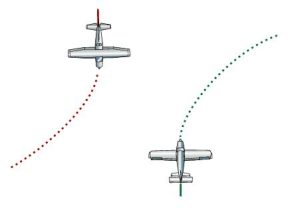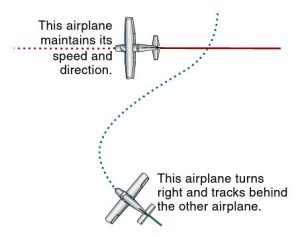Cessna 1 – 2 – Alpha – Sierra – Alpha traffic 1 o’clock in three miles same altitude southbound. What, traffic? I’m pretty sure traffic doesn’t start till like 5 o’clock—3 mile backup, maybe there’s an accident? Well there’s no accident, but there’s a good chance there will be if you have no idea what the air traffic controller just told you.
Often times when operating under flight following and when in controlled airspace ATC will provide you with traffic advisories. These advisories are given for the obvious reasons: to prevent a midair collision and maintain separation. When a controller refers to a direction in relation to a time (12 o’clock, 6 o’clock) they are basing that direction off a standard 12-hour clock. With 12 o’clock being directly in front of you and 6 o’clock being directly behind you.
It’s important to remember though on a radar screen a controller can only see your ground track or true course. The controller has no idea in which direction the nose of your aircraft is actually pointing. A controller might report an aircraft at your 12 o’clock but it might actually be more towards your 1 o’clock if you had a 20 degree left wind correction angle. If a traffic advisory is given it is the pilots responsibility to acknowledge receipt of advisory and inform the controller if traffic in sight. An example of acknowledgement could be, “…traffic in sight will maintain visual separation, Cessna Alpha-Sierra-Alpha.”
Part of maintaining visual separation from other aircraft is a full and complete understanding of right-of-way rules. Much like in a car where the right-of-way is given to the vehicle to the right the same theory of rules exists for aircraft and is outlined in 14 CFR §91.113.
§91.113 Right-of-way rules: Except water operations.
(a) Inapplicability. This section does not apply to the operation of an aircraft on water.
(b) General. When weather conditions permit, regardless of whether an operation is conducted under instrument flight rules or visual flight rules, vigilance shall be maintained by each person operating an aircraft so as to see and avoid other aircraft. When a rule of this section gives another aircraft the right-of-way, the pilot shall give way to that aircraft and may not pass over, under, or ahead of it unless well clear.
(c) In distress. An aircraft in distress has the right-of-way over all other air traffic.
(d) Converging. When aircraft of the same category are converging at approximately the same altitude (except head-on, or nearly so), the aircraft to the other’s right has the right-of-way. If the aircraft are of different categories—
(1) A balloon has the right-of-way over any other category of aircraft;
(2) A glider has the right-of-way over an airship, powered parachute, weight-shift-control aircraft, airplane, or rotorcraft.
(3) An airship has the right-of-way over a powered parachute, weight-shift-control aircraft, airplane, or rotorcraft.
However, an aircraft towing or refueling other aircraft has the right-of-way over all other engine-driven aircraft.
(e) Approaching head-on. When aircraft are approaching each other head-on, or nearly so, each pilot of each aircraft shall alter course to the right.
(f) Overtaking. Each aircraft that is being overtaken has the right-of-way and each pilot of an overtaking aircraft shall alter course to the right to pass well clear.
(g) Landing. Aircraft, while on final approach to land or while landing, have the right-of-way over other aircraft in flight or operating on the surface, except that they shall not take advantage of this rule to force an aircraft off the runway surface which has already landed and is attempting to make way for an aircraft on final approach. When two or more aircraft are approaching an airport for the purpose of landing, the aircraft at the lower altitude has the right-of-way, but it shall not take advantage of this rule to cut in front of another which is on final approach to land or to overtake that aircraft.


Let’s look at a few example of right-of-way rules.
An airplane and an airship are converging. If the airship is left of the airplane’s position, which aircraft has the right-of-way?
⇓
⇓
⇓
An airship has the right-of-way over an airplane or rotorcraft. 91.113(d)(3).
Which aircraft has the right-of-way over all other air traffic, an airship, an aircraft in distress, or an aircraft on final approach to land?
⇓
⇓
⇓
An aircraft in distress has the right-of-way over all other air traffic. 91.113(c).
So getting back to the first sentence, at this point you should be able to interpret from ATC’s traffic advisory that an aircraft is heading in our general direction. It is in our best interest to identify that traffic and take any necessary action to avoid and maintain separation. Remember flying in visual meteorological conditions (VMC) it is always the pilots responsibility to see and avoid, this holds true even if operating under instrument flight rules (IFR).






